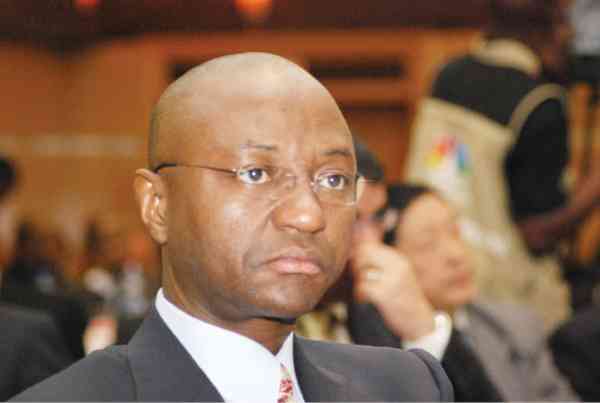
In honour of the late Tayo Aderinokun, the Managing Director, GTBank who passed on recently, Weekly Review serves one of the many pro-art pesentations he made in recent time. The late banker, an avid art enthusiast and patron of some bodies in the creative industry died penultimate Tuesday in a hospital in London, U.K. after protacted ailment. He was aged, 57. Excerpt from his essay originally entitled, The Economics of Nigerian Film, Art and Business:
THE world has continued to marvel at how Nigerians “manufacture” and “fabricate” scores of movies in a week. It is reported that but for India, Nigeria produces more movies in quantitative terms than any other country in the world. As joint stakeholders in the development of our motherland, I hope that my presentation today on the “social economics” of the movie industry will provoke processes that could move the industry forward. In the course of this presentation, I will be inviting you to join me as we journey through the past, the present and the future of the Nigerian film industry. There is a saying that today is tomorrow’s yesterday, in other words, where we are today is a reflection of our past and a foreshadow of our future.
The size of our population and the diverse cultures within it combined with the raw talents that abound within Nigeria makes the phenomenal growth of the film industry inevitable.
It is heart-warming though to note that Nigerian movies already dominate TV screens all over West Africa and going even as far as Central and Southern Africa. There is also a Western dimension to this export market. According to the Filmmakers Cooperative of Nigeria, every film in Nigeria has a potential audience of 15 million people within the country and about 5 million outside. These statistics may be somewhat conservative considering that half of West Africa’s 250 million people are Nigerians and according to the World Bank, slightly over 7 million Nigerians are scattered around the world, most of them in the developed economies. There is a school of thought that talks about the rebirth of the film culture in Nigeria. They claim that like in a horror movie, the infant film market was gruesomely butchered at the altar of the oil boom together with other sectors of the economy. The Indigenization Decree of 1972, which sought to transfer ownership of about 300 cinema houses in the country from their foreign proprietors to Nigerians did little to help matters. Though this transfer resulted in the eruption of the latent ingenuity of Nigerian playwrights, screenwriters, poets, and film producers, the gradual dip in the value of the naira, combined with lack of finance, marketing support, quality studio and production equipment as well as inexperience on the part of practitioners, hampered the growth of the local film industry.
At this juncture, I would like to go back a little in history. Film as a medium first arrived on our shores in the form of itinerant peephole hawkers of still
pictures. These were soon replaced with roving cinemas, which began feeding us with doses of American western films.
Edgar Rice Buroughs 1935 film Sanders of the River which was partly shot in Nigeria helped in putting Nigeria on the world film map through the participation of late Orlando Martins (1899 – 1985) who acted in the film alongside the American actor Paul Robeson. Orland Martins also featured in Man from Morocco and Black Libel – his first film, which was never finished but gave him the needed experience. It was however the part of Magole the witch doctor in Men of Two Worlds that put him in the public eye. Well before these films, Glover Memorial Hall is on record as having been the first venue to show a film in Nigeria in August 1903. Documentaries on the Queen’s visits to Nigeria, English football matches, Westminster Parliamentary debates, and government-sponsored films on health and education as well as legendary cowboy films soon began dominating our cinemas in the late ‘50s up to independence.
Most of us old enough to remember this era of the Nigeria society refer to it as the good old ‘50s and ‘60s and it was perfect timing for a love affair between Nigerian film and Nigerian music. Sadly, we had neither the technology nor the means to do our own films and had to be satisfied with mostly foreign fare. Soon vast acres of our urban surroundings became flooded with wall posters of alien culture in the form of American, Indian, Chinese, and Japanese films. Our kids caught on to the Kung-fu and Karate culture. Nigerians began to know more about Bruce Lee, James Bond, and the travails of the American Indians than they did about the Mbari Mbayo cultural group, Hubert Ogunde’s troupe or other socio-cultural history of Nigeria.
Some significant successes were recorded after independence when for about ten years after the Nigeria civil war, Nigerian literature and theatre got introduced to motion picture. Representative of this new wave were the works of Ogunde, a doyen of Nigerian art who understood that film and theatre were vehicles for promoting indigenous language, art and culture. The Nigerian nightlife scene subsequently came alive. Highlife music was the in-thing and the music of the Koola Lobitos, The Oriental Brothers, I. K. Dairo, Rex Jim Lawson, E. T. Mensah, and Victor Olaiya reigned. Ola Balogun’s post civil war flick, Amadi took us back to the pre-civil war days when Nigeria was one huge undivided house where Igbo musicians sang Yoruba highlife and Yorubas sang Hausa songs. Amadi was an Igbo film made by a Yoruba man and was clearly a glimpse from the future of the film industry in Nigeria. This early example of Nigerian art on celluloid using the best of Western film techniques, was a breath of fresh air even if it was a low technology, low budget experiment unable to impress the market against the dominance of imports which though exotic did little to promote Nigerian art. The film Bisi – Daughter of the River was another fair effort on celluloid, which captured Nigerian culture on film. Dinner with the Devil was another first generation Nigerian film by the duo of Sanya Dosunmu and Wole Amele. Eddie Ugbomah’s The Great Attempt was also another valiant film which was unfortunately censored by the authorities. Several decades later, the late Ogunde featured in Joyce Cary’s Mister Johnson, a film that did little to elevate the sad perception of Blacks and Africans. Thankfully in the 1980’s, the TV serialisation of Chinua Achebe’s Things Fall Apart became hugely successful. I also recall the small screen successes of the Adio Family, Village Headmaster, Cock Crow at Dawn, The Masquerade, Mirror in the Sun, Checkmate, Sura The Tailor, Awada Kerikeri and Second Chance on national television and how these productions were indeed instrumental to the revival of the local film industry and hence the birth of the home video culture in Nigeria. Later in time, the Austerity Measures of the early ’80s and the Structural Adjustment Programme that succeeded it, helped in no small measure in increasing the level of poverty in the land. The Entertainment Industry was one of the worst victims and had to move indoors. The few cinema houses existing either had to close shop or were taken over by religious bodies. This accelerated the birth of home video entertainment. Credit must now be given to our second generation film industry pioneers – Kenneth Nnebue, Amaka Igwe, Tunde Kelani, Zeb and Chico Ejiro, The Amata brothers, Femi Lasode, Olu Jacobs, Joke Jacobs (nee Silva), Liz Benson, Richard Mofe Damijo, Zachee Orji, Pete Edochie, Sam Loco Efe, U.S. Galadima, Yinka Quadri, Genevieve Nnaji, Jide Kosoko, Omotola Ekehinde and others – who inherited, without hesitation, the commercial and artistic traditions of Nigerian film and theatre from the likes of Hubert Ogunde, Moses Olaiya, Duro Ladipo, Ola Balogun, Wole Amele, Eddie Ugbomah, just to name a few, and began to tell our stories using the video format. By 1993 when the National Film Festival was held for the first time our film industry score sheet was moderate – about 25 English films, five Hausa films, 50 Yoruba and One Igbo film.
In Western societies, a film’s commercial lifespan would normally begin with a box office or cinema release, then video release, then broadcast on fee-paying television, and finally on public television. Producers and marketers would then generate the appropriate promotion and publicity to maximize profitability out of each phase. The Nigerian experience with the video culture so far has shown that without piracy, there are huge potentials for making money in the industry. In South Africa, I understand that video distribution usually doubles or triples a movie’s revenues. The video boom is therefore not just a Nigerian phenomenon. Video appears to be the home entertainment mainstay for the world’s developing countries.
From all indications, the future of the Nigerian movie industry is promising. I understand that every day, about three new low budget movies are released into the market. Each film is then replicated into about 200,000 video cassettes and distributed to markets, video clubs and eventually various homes. This process creates jobs and income for the people involved in the production, distribution and marketing of the movies. It is only when we change our paradigm and see film production as big business, that the film industry will take its rightful position in the economy.
The Indian film industry has been projecting India’s culture globally for over 50 years and has remained one of the most important foreign exchange earning sources for that country. Francophone West African films, which get showcased at FESPACO, the Pan-African Film and Television Festival of Ouagadougou, which holds in the Burkinabe capital every two years has helped in improving the quality and global appeal of Francophone films. As a result, these countries’ film industries have contributed significantly to their respective economies. The United States of America is the best example of a perfect union between the film and the financial services industries. Do you know that the American movie industry is the second largest export revenue earner for that country, after the aviation industry? Thanks to Hollywood and its spin offs, the state of California, with a gross domestic product of $1.4 trillion, is the fifth largest economy in the world, richer than the combined wealth of all the 54 countries in Africa. Today, underscoring the industry’s contribution to the rest of American society, the current Governor of California is Arnold Shwarzzenegger, an actor (Shwarzzenegger, Govenor of Californoia at the time of presentation of this paper has already served his full tenure as helmsman of the state). Former President Ronald Reagan was also a Hollywood actor. These American examples show us what the Nigerian movie industry can become in terms of stature and relevance in society.
Let me say that the need for partnership between Nigerian banks and the film industry are obvious. We all now know from the American experience that film is big business. As financial intermediaries in the economy, banks have a key role to play in the development of the industry. Banks are interested in helping to build successful businesses out of ideas and if the film industry should open itself up to the same evaluation and analysis that banks subject all their borrowers to, banks would really want to lend to them. With the support of the financial sector, the film industry will certainly rise to prominence.
Before I conclude I have some questions for CORA (Committee for Relevant Art). These are questions that banks would like to have answers to before supporting the Nigerian film industry:
• How much is the film industry worth today?
• How much does it cost to produce a good movie?
• What is the annual turnover of an average movie producer?
• Do firms in the movie industry have collateral to pledge for credit?
• Do companies in the film industry have audited accounts?
• Do companies in the film industry have formal structures?
Bankers usually do not start a banking relationship until after conducting due diligence on the institution of their interest. This usually involves an assessment of need and an analysis of the credit risks involved. This is because they want to be able to determine, to a large extent, the viability of the project they finance. So far, our film industry lacks the structure to provide positive answers to my questions. I am therefore suggesting that the Nigerian film industry become better organised, and start to maintain proper records and accounts, engage the services of auditors and have formal organisational structures. When this is done, banks will find the industry more amenable for support. The banks will also be able to:
• Learn about the dynamics of the film industry
• Know the people driving the film industry
• Easily provide credit in the form of loans to the industry
• Provide financial advisory services
• Serve the industry’s domestic and international money transfer need
• Help midwife this booming sector of the economy which has great potentials for growth and foreign exchange denominated earnings.
One should also ask what the movie industry can do for the financial services industry and by extension, for the country.
Already, beyond being a ready-made pipeline for the discovery of young artistic talent, its potential for generating direct and indirect employment is well known.
The positive impact of the film industry on the image of Nigeria should also go a long way towards attracting foreign direct investments into the country.
We all know that Nigerian home videos are extremely popular with Africans especially Nigerians abroad. Our films have become ready substitutes for western productions. Through these movies Africans are experiencing a cultural connect worldwide, something which foreign movies cannot provide. Recently, South Africa’s satellite TV company Multichoice DSTV introduced its AfricaMagic channel which shows mostly Nigerian movies to its over 1.5 million subscribers in Africa, Europe and the Middle East. With time, this exposure of our film market can only serve to improve the quality of our movies. It can be said that this is another form of cross-border trade, which will lead to positive interest in Nigeria, and all the things associated with our country.
So far, our film industry has evolved naturally, with almost no government involvement or influence. This is a good thing and I want to appeal to you all that it remains so. While Government participation is welcome, it should not be allowed to become a hinderance in any way. Government’s involvement in business enterprises has been known to generally hamper than assist its development.
My belief is that government should actually contribute in the area of fighting piracy which has become a plague afflicting several areas of the creative arts. The recent accord between the Filmmakers Cooperative of Nigeria (FCON) and the Filmmakers Association of Nigeria FAN, USA to bring an end to the piracy of Nigerian films in the United States is laudable and a good example of cross border, private sector led collaboration.
Closing Shot
In concluding, let me restate that banks need the film industry just as much as the film industry needs the banks. I believe that the film industry can be viable and has all the elements of being sustainable over the long term. Partnership between both sectors is therefore necessary if the movie industry is to achieve its full potentials. The future of this partnership abounds with several opportunities.
Aderinokun made this pesentation at the 50th Art Stampede Session Of The Committee For Relevant Art (CORA) held at The National Theatre, Iganmu, Surulere, Lagos, Nigeria on Sunday March 7th, 2004.



















